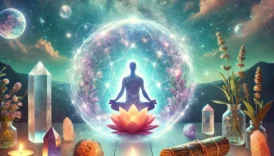Astral Travel Techniques
Astral travel, often described as the temporary separation of consciousness or the “astral body” from the physical body, has captivated spiritual seekers and mystics for centuries. Although this phenomenon might sound akin to lucid dreaming, astral travel is marked by distinct techniques, potential risks, and deeper spiritual underpinnings. With the growing interest in metaphysical subjects, questions regarding the nature of astral travel, its history, and how to practice it responsibly continue to surface. In this comprehensive guide on “Astral Travel Techniques,” we will explore the concept in detail, from its historical and cultural backgrounds to practical methods, potential hurdles, and advice on safe exploration.
- Astral Travel Techniques
- A Brief Historical and Cultural Background of Astral Travel
- What Is Astral Travel?
- The Scientific Perspective on Astral Travel
- Core Principles: Intention, Concentration, and Energy
- Preparation: Mental and Spiritual Cleansing
- 1. Meditation Practice
- 2. Emotional Release
- 3. Physical Relaxation
- Common Astral Travel Techniques
- 1. The Rope Technique
- 2. The Silver Cord Technique
- 3. Transitioning from Sleep Paralysis
- 4. Binaural Beats and Sound Frequency Techniques
- Advanced Methods and Spiritual Practices
- Possible Challenges During Astral Travel
- 1. Fear and Panic
- 2. Negative Entities
- 3. Fear of Not Returning
- 4. Reality vs. Hallucination
- Entities You Might Encounter in Astral Realms
- Safely Ending an Astral Travel Session
- The Benefits of Astral Travel in Daily Life
- Frequently Asked Questions
- Can I be harmed during astral travel?
- Is astral travel possible for everyone?
- How does astral travel differ from lucid dreaming?
- How long does astral travel last?
- How can I avoid negative entities?
- Final Thoughts
- References
A Brief Historical and Cultural Background of Astral Travel
Throughout history, various civilizations developed methods for reaching beyond physical existence to investigate consciousness. Ancient Egypt, Ancient Greece, Indian Vedantic tradition, and Tibetan Buddhism, among others, have included references to astral travel—or the separation of spirit from the physical form. In Ancient Egyptian culture, “The Egyptian Book of the Dead” highlights the soul’s journey after death, suggesting an understanding of other realms and the soul’s capacity to traverse them. These ideas were later perpetuated through mystical forms of Christianity, Sufism, and many esoteric schools of thought. [1]
In ancient Indian teachings, meditation and trance states have been integral to understanding the relationship between “Atman” (the individual soul) and “Brahman” (the universal soul). Early textual sources in the Upanishads illustrate experiences similar to astral travel. Likewise, Tibetan Buddhism introduces the concept of “Bardo,” describing liminal states between life, death, and beyond, which some interpret as overlapping with out-of-body experiences. These long-established traditions underscore that astral travel is neither a recent cultural fad nor a mere pastime, but a gateway to deeper spiritual enrichment. [2]
What Is Astral Travel?
Astral travel, sometimes confused with lucid dreaming, fundamentally involves the projection of consciousness while remaining in a borderline awake state. During this experience, practitioners believe they leave their physical body behind and journey through what is often called the “astral plane” or “energy plane,” guided by an astral or subtle body. From a spiritual standpoint, the astral plane is distinct from physical reality, offering different laws of space, time, and movement. Some accounts even suggest that an experienced traveler can instantly move to various locations or, in rare cases, glimpse different timelines.
Though intriguing and sometimes mysterious, astral travel is also investigated by modern psychology and neuroscience—particularly in relation to lucid dreaming, REM sleep, and trance states. Additionally, parapsychology has produced various studies attempting to verify reports of astral travel, though results remain inconclusive. [3] Nonetheless, the consistent testimonies of many practitioners and certain anecdotal research findings keep the conversation alive, hinting at the possibility that consciousness can, under specific conditions, access realities beyond the physical realm.
The Scientific Perspective on Astral Travel
In the academic community, astral travel has yet to gain universal acceptance because it is challenging to replicate under controlled laboratory conditions. However, the possibility of consciousness existing beyond the physical body continues to spark speculative debates in fields like quantum physics and consciousness studies. Research on near-death experiences (NDEs), for instance, demonstrates that people sometimes recall vivid, structured experiences even when critical biological functions have slowed or stopped. [4] The parallels between astral travel and NDEs have raised further curiosity regarding whether the human mind can, in fact, transcend normal sensory and physical constraints.
In psychology, many scholars interpret astral travel in the context of hypnagogic or hypnopompic states—phases that border sleep and wakefulness. During these transitional states, the brain’s sensory filters are partially deactivated, and individuals may more easily enter lucid dreams or experiences akin to astral projection. Whether these experiences are purely internal or indicative of an external metaphysical dimension remains a topic of spirited debate.
Core Principles: Intention, Concentration, and Energy
Successfully undertaking astral travel often involves focusing on three core principles:
- Intention (Will): An unequivocal, firmly held desire to have the experience is crucial. Intention aligns mental energies, potentially aiding in deeper trance states and clearer astral travel sessions.
- Concentration: A busy or restless mind hinders entry into deep meditative or trance-like states. Regular daily meditation can help strengthen concentration and mental clarity.
- Energy Work: Practices such as yoga, tai chi, reiki, or other forms of energetic exercises that fortify the “astral body” may ease the process of astral travel. Working with chakras or with concepts like “chi” or “prana” can be especially supportive.
Preparation: Mental and Spiritual Cleansing
Before diving into astral travel, preparing mentally and spiritually can greatly enhance the experience. A cluttered mind or unresolved emotional baggage can manifest as fear or negative imagery during astral travel. Here are a few steps to prime yourself:
1. Meditation Practice
Daily meditation sessions lasting 10–20 minutes help calm the mind and sharpen awareness. By focusing on the breath or a mantra, you can create a positive energetic space that naturally reduces anxiety and internal noise. Consistent meditation helps you react more serenely to any unexpected phenomena in astral realms.
2. Emotional Release
During astral travel, repressed fears or unaddressed stress can surface in surprising ways. Keeping a journal, engaging in art therapy, or seeking counseling are effective strategies for releasing emotional burdens. By confronting and resolving these fears before attempting astral travel, you reduce the likelihood of encountering distressing episodes.
3. Physical Relaxation
Many practitioners attempt astral travel before sleep, when the body naturally eases into relaxation. Experiment with different postures: lying on your back or adopting a slightly upright position may help avoid drifting off to sleep too quickly, allowing you to stay close to the meditative border between wakefulness and slumber.
Common Astral Travel Techniques
There are numerous methods people use to achieve astral travel. Effectiveness varies according to individual temperament, focus levels, and energy alignment. Below are some widely practiced techniques:
1. The Rope Technique
In this method, you lie on your back and relax your muscles through breathing exercises or progressive muscle relaxation. Visualize a rope or cord hanging from the ceiling within reach. Mentally imagine pulling yourself upward by this rope, feeling the subtle shifts or vibrations in your body. These tingling sensations are often interpreted as signals that the astral body is preparing to separate from the physical form.
2. The Silver Cord Technique
In many esoteric teachings, the “silver cord” is the energetic tether between your physical body and astral body. As you enter a trance state, visualize yourself gently floating above your body, connected by this luminous silver cord. Believing in this bond can ease any anxiety about becoming lost in the astral realm or being unable to return.
3. Transitioning from Sleep Paralysis
Some individuals experience sleep paralysis, where the body is immobilized between wakefulness and full sleep. While frightening due to the inability to move, this state presents a window for astral travel. If you remain calm and direct your consciousness to your astral body, you may more easily separate from the physical body.
4. Binaural Beats and Sound Frequency Techniques
Binaural beats and isochronic tones are types of audio stimulus that can help coax brainwaves into the Alpha or Theta range. Many meditators report that these relaxed states facilitate out-of-body experiences or lucid dreams. While not universally backed by scientific consensus, anecdotal evidence suggests such audio tracks can serve as a catalyst for deeper meditation and astral projection.
Advanced Methods and Spiritual Practices
As one becomes more adept at astral travel, additional advanced techniques may come into play. These include Hermetic principles, Kabbalistic practices, mantra recitations, or Tibetan dream yoga. Such systems do not solely focus on astral travel but use it as part of a larger framework for spiritual growth, self-realization, and connection with universal consciousness.
For instance, Tibetan dream yoga trains practitioners to gain awareness within dreams, using them as platforms for enlightenment. Astral-like experiences are frequently reported in conjunction. In Kabbalistic systems, astral travel may be symbolically interpreted as navigating the Sephiroth, the interconnected spheres representing various aspects of divine and human consciousness. Here, the journey involves both personal introspection and communion with higher universal energies.
Possible Challenges During Astral Travel
Despite its potential for profound self-discovery, astral travel is not without risk and can present the following challenges:
1. Fear and Panic
Encountering the sensation of being outside one’s body can trigger panic. Excessive worry or an unprepared mind may cause the experience to end abruptly, pulling the consciousness back to the physical form. Proper mental preparation significantly reduces such episodes of fear.
2. Negative Entities
Certain esoteric schools posit the existence of various beings inhabiting the astral planes. While some are benevolent, others might emit a darker, more unsettling energy. Meeting these entities can be alarming, which is why practitioners often emphasize protective meditation, focusing on positive intentions, and techniques like visualizing a protective “circle of light.”
3. Fear of Not Returning
Beginners sometimes worry that they might become separated from their physical bodies indefinitely. However, esoteric teachings commonly assert the presence of an energetic link—often conceptualized as the silver cord—that draws consciousness back to the body whenever needed. Mindful intent and a calm demeanor further ensure a smooth return.
4. Reality vs. Hallucination
Distinguishing a genuine astral experience from a vivid dream or hallucination can be tricky. Recording details, emotions, and sensations in a journal soon after the experience can help you detect patterns and discern repeated symbols. Over time, consistency in reported data may suggest which elements are more than mere fantasy.
Entities You Might Encounter in Astral Realms
According to various metaphysical traditions, the astral plane is home to different energy strata and entities, which can include:
- Guiding Entities or Spirit Guides: Usually positive, higher-vibrational beings believed to offer support and insight.
- Souls of the Departed: Some people believe that spirits of the deceased exist in the astral realms and may attempt communication with the living.
- Lower-Vibrational Beings: Entities emanating more negative energies that might engender fear or discomfort.
When interacting with such beings, maintaining clear personal boundaries and positive energy is vital. As in the physical world, you retain the right to end or decline any unwanted interaction.
Safely Ending an Astral Travel Session
Most of the time, simply wishing to return or experiencing strong emotions will bring you back to your body. However, if you want a more controlled exit from the astral realm:
- Stated Intention: Mentally affirm, “I now choose to return to my body,” or “I end this experience here.”
- Deep Breathing: Take several slow, deliberate breaths, focusing on the sensation of air filling your lungs and the weight of your physical form.
- Gentle Body Movements: Wiggle your fingers or toes, gradually becoming more aware of the physical body and reactivating your musculoskeletal system.
Allow yourself a few minutes to sit quietly, reflect on what you experienced, and make any necessary notes. Balancing your emotional state before resuming normal activities can help integrate the journey.
The Benefits of Astral Travel in Daily Life
Astral travel can offer more than just excitement. It may also enrich everyday life and spiritual awareness in several ways:
- Expanded Consciousness: Experiencing different dimensions can inspire a broader view of existence, challenging the limitations of everyday perception.
- Overcoming Fears: Successfully navigating challenges in the astral world can bolster courage and resilience, fostering greater self-confidence.
- Spiritual Growth: Interacting with benevolent guides or higher energy fields can accelerate personal transformation and deepen one’s connection with the cosmos.
- Enhanced Creativity: Access to the subconscious and the symbolic imagery of the astral realm can spark novel ideas and innovative solutions, benefiting artists, writers, and problem-solvers alike.
Frequently Asked Questions
Can I be harmed during astral travel?
Physically, astral travel is not commonly associated with bodily harm. Yet, psychological distress can occur if fear or panic sets in. Positive intention and a grounded approach help create a safer environment.
Is astral travel possible for everyone?
In theory, anyone with consciousness has the potential to experience astral travel. However, the likelihood of a lucid or fully conscious experience can vary based on individual temperament, dedication to practice, and openness to the phenomenon.
How does astral travel differ from lucid dreaming?
While both experiences occur outside ordinary waking reality, lucid dreaming happens within the dream state, where you realize you are dreaming. Astral travel, by contrast, is described as shifting into a subtle-energy dimension while maintaining an awake awareness or a state close to wakefulness.
How long does astral travel last?
Astral experiences can feel very brief—just a few minutes—or subjectively long, sometimes perceived as extended journeys. Notably, the astral plane is believed to have altered or fluid perceptions of time, making direct comparisons with physical-world durations complex.
How can I avoid negative entities?
To minimize encounters with lower-vibrational beings, maintain a positive mindset and a clear, protective intention. Techniques like surrounding yourself with white or golden light can also help repel undesirable energies. Reducing fear is key since it can attract negative experiences.
Final Thoughts
Astral travel holds a unique allure for many spiritual explorers, offering the chance to discover realms beyond conventional perception. Beyond the fascination, it can be a potent tool for inner growth, self-reflection, and expanded understanding of the universe. Nonetheless, individuals seeking this extraordinary experience should approach it with mindfulness, preparation, and respect for their emotional and mental well-being. With adequate knowledge, consistent meditation practice, and protective measures, astral travel can become a transformative journey, guiding you closer to the infinite aspects of consciousness and reality.
References
- Budge, E. A. Wallis. The Egyptian Book of the Dead. T. & T. Clark, 1895.
- Upanishads (800–500 BCE). Writings on Hindu Philosophy.
- Varvoglis, M. Parapsychology: A Handbook for the 21st Century. McFarland & Company, 1988.
- Moody, R. Life After Life: The Investigation of a Phenomenon—Survival of Bodily Death. HarperCollins, 1975.





